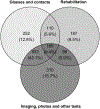Veterans with Traumatic Brain Injury-related Ocular Injury and Vision Dysfunction: Recommendations for Rehabilitation
- PMID: 34882607
- PMCID: PMC8720069
- DOI: 10.1097/OPX.0000000000001828
Veterans with Traumatic Brain Injury-related Ocular Injury and Vision Dysfunction: Recommendations for Rehabilitation
Abstract
Significance: We know the prevalence of traumatic brain injury (TBI)-related vision impairment and ocular injury symptoms. Lacking is an understanding of health care utilization to treat these symptoms. Utilization knowledge is important to structuring access to treatment, identifying clinical training needs, and providing evidence of the effectiveness of treatment.
Purpose: This article reports rehabilitation, glasses/contacts, and imaging/photography/video recommendations made by optometrists and ophthalmologists as part of the Department of Veterans Affairs-mandated Performance of Traumatic Brain Injury Specific Ocular Health and Visual Functioning Examination administered to veterans with TBI at Department of Veterans Affairs polytrauma specialty facilities.
Methods: Using a retrospective design, natural language processing, and descriptive and regression statistics, data were analyzed for 2458 Operation Enduring Freedom/Operation Iraqi Freedom veterans who were administered the mandated examination between 2008 and 2017.
Results: Of the 2458 veterans, vision rehabilitation was recommended for 24%, glasses/contacts were recommended for 57%, and further imaging/photography/video testing was recommended for 58%. Using key words in the referral, we determined that 37% of veterans were referred to blind rehabilitation, 16% to occupational therapy, and 3% to low-vision clinics. More than 50% of the referrals could have been treated by blind rehabilitation, occupational therapy, or low-vision clinics. Rehabilitation referrals were significantly associated with younger age, floaters, photosensitivity, double vision, visual field and balance deficits, dizziness, and difficulty reading. In comparison, prescriptions for glasses and contacts were associated with older age, photosensitivity, blurred vision, decreased visual field and night vision, difficulty reading, and dry eye. Imaging/photography/video testing was associated with floaters, photosensitivity, and headache.
Conclusions: Findings delineate service delivery models available to veterans with TBI-related vision impairment. The challenge these data address is the lack of clear paths from diagnosis of TBI to identification of vision dysfunction deficits to specialized vision rehabilitation, and finally to community reintegration and community based-vision rehabilitation.
Copyright © 2021 American Academy of Optometry.
Conflict of interest statement
Conflict of Interest Disclosure: No financial conflicts of interest exist for any author.
Figures






References
-
- O’Neil M, Gleitsmann K, Motu’apuaka M, et al. Visual Dysfunction in Patients with Traumatic Brain Injury: A Systematic Review. Washington, DC: Department of Veterans Affairs Health Services Research & Development Service; 2014. - PubMed
-
- Capo-Aponte JE, Jorgensen-Wagers KL, Sosa JA, et al. Visual Dysfunctions at Different Stages after Blast and Non-Blast Mild Traumatic Brain Injury. Optom Vis Sci 2017;94:7–15. - PubMed
-
- Sutter P. Rehabilitation and management of visual dysfunction following traumatic brain injury. In: Ashley MJ, Krych DK, eds. Traumatic Brain Injury Rehabilitation. Boca Raton, FL: CRC Press; 1995:187–219.
-
- Vision Center of Excellence. Walter Reed National Military Medical Center. Clinical Recommendation for the Eye Care Provider Eye and Vision Care following Blast Exposure and/or Possible Traumatic Brain Injury; 2015. Available at: https://www.va.gov/optometry/docs/VCE_OMS_Eye_Care_Provider_CR_11FEB2015.... Accessed October 15, 2021.
-
- National Alliance for Eye and Vision Research. Frick KD. Costs of Military Eye Injury, Vision Impairment, and Related Blindness and Vision Dysfunction Associated with Traumatic Brain Injury (TBI) without Eye Injury; 2012. Available at: www.eyeresearch.org/pdf/costofmilitaryblindness.pdf. Accessed October 15, 2021.
Publication types
MeSH terms
Grants and funding
LinkOut - more resources
Full Text Sources
Medical

